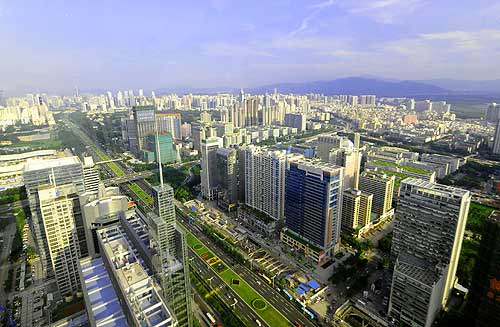|
 |
|
SPECIAL EXPANSION: Tall buildings stand in the center of Shenzhen, which has expanded the scope of the special economic zone to cover the whole city(ZHOU WENJIE) |
Currently, most of the readjustments are occurring in the four municipalities and developed coastal areas with a cluster of large and medium-sized cities.
In the early years after the founding of the People's Republic of China in 1949, the division of districts in large and medium-sized cities did not need approval by the Central Government, said Zhu Lijia, a professor at the Chinese Academy of Governance. There was also no uniform standard about the number and size of urban districts, with both decided by the cities themselves. As a result, some cities have too many urban districts, while others have too few.
In 2003, the Central Government issued an action outline for China's sustainable development in the early 21st century, stating that readjustments to administrative divisions will be carried out in a scientific and steady manner at the proper time. Establishing an institutional framework catering to sustainable urban development is also needed.
Development
Among Beijing's 18 districts and counties, Chongwen and Xuanwu districts were the smallest in both scale and population, Du said. Limited by development space, their economic growth has fallen behind that of Xicheng and Dongcheng districts. After merging with their respective districts, the two can share more administrative resources to make urban management more flexible. Furthermore, the readjustment can also make up for the gap of economic and social development between the south part and the north part of the city.
Information released by the Beijing Municipal Government says there are four advantages for the readjustment: it will promote the even development between the south and north parts of the city proper; it will improve the city center's bearing capability and service level; it will enhance the overall protection of Beijing as a famous city of history and culture; and it will reduce administrative costs and increase administrative efficiency.
In Shenzhen, the government said after the expansion, the special economic zone's area will be six times that of the present area, which will help increase the city's development space significantly. The expansion also puts an end to the long-existing problem that the city must apply different regulations inside and outside the special economic zone.
In the past, the industrial layout and major infrastructure in Shenzhen focused on the special economic zone, while the area outside the special economic zone wasn't given the same consideration. This impeded the city's overall development and made the area outside the special economic zone less developed. Expanding the special economic zone will facilitate Shenzhen's overall development and help ease bottlenecks concerning land, resources, energy and population.
Layout
"After readjusting urban divisions, cities must also review and solve the problems that have impeded productivity," said Dong Ke with the China Academy of Urban Planning and Design.
Dong said in urban planning, the layout of space in a city should match its administrative division, otherwise it will affect the optimal allocation of resources, such as those reserved for the city's industrial layout, supporting public facilities, environment protection, garbage disposal plants and sewage works.
Vile competition that may have existed between previously unmerged districts could be curbed by the readjustments. The newly formed district-level government must properly handle the relationship between invigorating grass-roots organizations and strengthening macro-control. While reducing the number of government organizations, the government needs to maintain the efficiency of grass-roots organizations and inspire their initiatives.
Readjustment to administrative divisions can free up more space for a city to develop its economy, and the reality now is that the readjustments simply expand the area of a new district, allowing it to administer two or more districts.
Addressing this issue, Niu Wenyuan, head of the research group on the sustainable development strategy at the Chinese Academy of Sciences, said scientific and reasonable administrative divisions are conducive to the overall sound development of cities and promote balanced regional development. However, bigger is not always better, and the size of each district should be readjusted in accordance with real demand, instead of being expanded for expansion's sake. The readjustment should be made only for the benefits of people and the need of development, he said.
Readjustments in the Past Year
Beijing:
Merging Dongcheng and Chongwen districts into New Dongcheng District,
and Xicheng and Xuanwu districts into New Xicheng District.
Shanghai:
Incorporating Nanhui District into Pudong District. The New Pudong District
covers 1,210 square km, one fifth of the total area of Shanghai.
Tianjin:
Merging Tanggu, Hangu and Dagang districts into Binhai New District,
which covers 2,270 square km.
Chongqing:
Merging portions of Jiangbei, Yubei and Beibei districts as well as the
national-level economic and technological development zone, hi-tech
development zone and Lianglucun bonded zone into Liangjiang New District,
which covers 1,200 square km.
Shenzhen, Guangdong Province:
Expanding the scope of the special economic zone from Luohu, Futian,
Nanshan and Yantian districts to the whole city and incorporating Baoan and Longgang districts into the special economic zone. The area of the special
economic zone expands from 327.5 square km to 1,991 square km.
Xiamen, Fujian Province:
Expanding the scope of the special economic zone from Xiamen Island to
the whole city. The area of the special economic zone expands from 150 square
km to 1,560 square km.
Shenyang, Liaoning Province:
Expanding the urban areas of Heping, Shenhe, Dadong and Huanggu districts,
and merging Dongling District, Hunnan New District and Hanggao Base into
Dahunnan District. The urban area extends 4 km to the north and south
respectively, 3 km to the east, and 25 km to the west.
| 